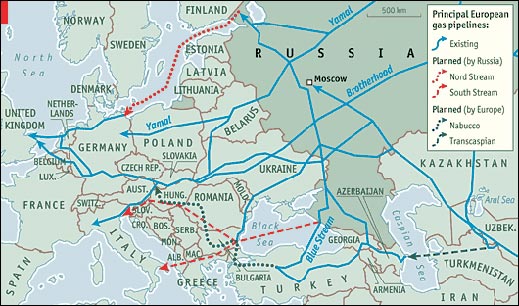
NABUCCO GAS PROJECT FACING A CASCADE OF DEFECTIONS
Publication: Eurasia Daily Monitor Volume: 5 Issue: 38
By:

Romania seems to be the one remaining loyal participant in the Nabucco pipeline project, which is planned to carry Caspian gas via Turkey and the Balkans to Central Europe. Defections are now cascading from this U.S.-backed, top-priority project of the European Union. The project can not survive on the existing form of support from Brussels and Washington, which remains mainly of a hortatory character, in the absence of access to Central Asian and Iranian gas. Opening such access could still rescue the Nabucco project from the collapse that now looms.
The last four weeks have witnessed a rapid transfer of loyalties to Gazprom’s rival project, South Stream, by four out of the five member countries in the Nabucco consortium. Austria’s government-controlled OMV company finalized agreements with Gazprom to turn Nabucco’s designated terminus and storage center, Baumgarten near Vienna, into a Gazprom-OMV 50%-50% company. OMV, which is Nabucco’s lead company, now proposes reserving half of the capacity of the Nabucco pipeline itself for Gazprom’s use. OMV share-boosting publicity, moreover, hinted at the possibility of a Gazprom-backed takeover by OMV of the private-owned MOL, the Hungarian partner in the Nabucco consortium (see EDM, January 29, February 5).
Concurrently, Bulgaria’s top political leaders and the Bulgargaz state company — a member of the Nabucco consortium — have concluded agreements with the Kremlin and Gazprom to include Bulgaria in the South Stream project (see EDM, January 24). This move also helps Gazprom to preempt Nabucco in the race for markets downstream and resources upstream and to keep Nabucco unbankable.
Using the Bulgarian springboard, Russia’s outgoing and incoming presidents, Vladimir Putin and Dmitry Medvedev, sealed a wholesale capture of Serbia’s energy sector for and by Gazprom (see EDM, January 28, February 27). Although Serbia is not a member of the Nabucco consortium, its inclusion in Gazprom’s South Stream project has opened the way for Gazprom to expand directly into Hungary from the south.
Gazprom is now winning the race against Nabucco in Hungary as well. On February 25 the country’s Socialist prime minister, Ferenc Gyurcsany, agreed with the visiting Medvedev in Budapest to extend the South Stream pipeline into Hungary. The privately owned MOL has no part in this venture. The Hungarian government shall specially create a state company in a 50%-50% partnership with Gazprom to build and operate South Stream’s Hungary section (Nepszabadsag, February 25; Interfax, MTI, February 25-27). With this, the Socialists are also ushering in a partial re-etatization of Hungary’s energy system through a Russian-controlled process.
In Vienna, consequently, OMV’s CEO Wolfgang Ruttenstorfer is hailing Gazprom’s arrival in Austria from Hungary through the South Stream project, in addition to the existing pipeline from the east, both headed for the Baumgarten terminal system that was supposed to be Nabucco’s (Format [Vienna], February 23).
The Turkish government is also evidencing a loss of confidence in Nabucco. Ankara seems to approach this project from two different perspectives. On one hand, it is bargaining hard for commercial advantage in a spirit of short-sighted opportunism, risking to delay Nabucco sufficiently for Gazprom’s South Stream to enjoy a head start and win the race. The Turkish government and its pipeline company Botas seem to play a winner-take-all game against the other consortium partners, rather than a win-win game, over the terms of pricing, trading, and transporting Nabucco gas by pipeline through Turkey. Such an approach partly reflects serious skepticism about the prospects of Nabucco’s second phase following a small-scale first phase.
At the same time, Turkey fears losing the opportunity to become a transit and hub country through Nabucco, in the absence of access to Iranian gas (which Turkey rightly deems essential) or Central Asian gas (to which only Washington and Brussels, not Turkey, can open access). Turkish officials also seem unnerved by unrealistic recommendations from Nabucco well-wishers to use gas from the Kurdish-inhabited northern Iraq for Nabucco’s second phase.
Consequently, Turkish officials increasingly urge enlisting Gazprom in the Nabucco project to deliver “Russian” gas — in fact, Central Asian gas volumes monopolized by Gazprom. Thus, Turkey’s Minister of Foreign Affairs Ali Babacan and Botas CEO Saltuk Duzyol publicly recommend using “Russian” gas at certain stages in the Nabucco project, for a substantial share of the planned pipeline’s capacity.
Moreover, Turkish officials also seek to enlist Gazprom for building gas storage sites in Turkey, according to Babacan’s media briefing on his talks with counterpart Sergei Lavrov and Industry Minister Viktor Khristenko in Moscow (Frankfurter Allgemeine Zeitung, February 22; Turkish Daily News, February 23). However, a storage deal with Gazprom would clearly have to involve also a pipeline deal with Gazprom, at Nabucco’s expense.
Babacan proposes a sui-generis approach to diversification: “We are open to including Russian [sic] gas in Nabucco. Every country is aiming at diversifying its energy resources. What actually matters for us is having the gas in the Nabucco pipeline come from a variety of sources” (Zaman, February 26). By this logic, Nabucco gas supplies would seem to require diversification away from the initially envisaged non-Russian gas, toward greater reliance on Russian-delivered gas. At a slightly deeper level, however, Turkish officials seem to wish to resuscitate Gazprom’s Blue Stream-Two project via Turkey, in lieu of South Stream, which bypasses Turkey altogether, and amid deepening skepticism about Nabucco’s prospects.




